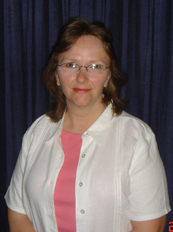 |
Terry Lukavsky Wiese |
“One of my brothers or sisters would be running and they’d break a leg,” Wiese said. “One time someone threw a softball from across the street, it hit the ground, rolled over my foot and my foot broke.”
Luke and Mary Lukavsky married in 1948. Nine of the 13 were born with a rare, genetic condition their mother had as well, called osteogenesis imperfecta. Translated, this Latin term means “imperfect bone from the beginning.”
“It was better to keep quiet about our broken bones,” Wiese said. But it wasn’t always possible. She recalls one of her brothers, a second-grader at the time, breaking his leg. His teacher didn’t believe him and sent him home. The little boy crawled six blocks to his house, where Wiese said their mother found him passed out on the doorstep. More than once, a doctor or nurse mistakenly accused the Lukavsky parents of physically abusing the children.
“Not only did we have to deal with suspicion about what caused our broken bones, my father sometimes had to fight to get the doctor to treat us because we didn’t have a lot of money,” she said. “I remember lying in a hospital hallway with a broken leg for a full day, in a lot of pain, before I was helped.”
|
Osteogenesis imperfecta (OI) is a genetic disorder characterized by bones that break easily, often from little or no apparent cause. There are at least four recognized forms of the disorder, representing a range of severities. For example, a person may have just a few or as many as several hundred fractures in a lifetime. While the number of people affected with OI in the United States is unknown, the best estimate suggests a minimum of 20,000 and possibly as many as 50,000. OI is caused by a genetic defect that affects the body’s production of type I collagen. Collagen is the major protein of the body’s connective tissue and can be likened to the framework around which a building is constructed. In OI, a person has either less collagen than normal, or a poorer quality of collagen than normal, leading to weak bones that fracture easily. |
“We would sing,” she says matter-of-factly.
“Singing is how we got into the hospitals. The doctors and nurses would invite us in, and we’d sing to one hospital ward, and then another.”
The children were able to see their injured sibling, and soon became known for something other than broken bones — the Lukavsky Family Singers.
The Lukavsky Family Singers will have a homecoming of sorts in Omaha this week. Six of Wiese’s siblings will join her in Omaha for the 15th Biennial National Conference on Osteogenesis Imperfecta (OI). They plan to perform at Thursday’s opening ceremonies.
Nearly 550 adults and children with OI are registered for the conference, which caters to families affected by OI, as well as medical professionals. UNMC and Children’s Hospital are teaming up to offer CME credits to medical professionals who attend the conference.
Wiese is now 46 years old, married and the mother of six children. She still occasionally breaks a bone, and despite the fact that three of her children have OI, she is filled with hope.
“I try not to dwell on negatives,” she said. “It’s so much more helpful to focus on things that are possible.”
Several years ago, for the first time in her life, Wiese discovered there was a medical treatment for OI. It’s an I-V infusion of a medication called Pamidronate.
Wiese calls it an infusion of hope.
“I have hope for my Daniel, for his future,” she said, of her fifth child.
Now 6, Daniel has a moderately severe form of OI, like his mother. Pamidronate belongs to a group of drugs called bisphosphonates. Regular infusions of this drug have been shown to increase bone mineral content, reduce fractures, increase mobility and decrease bone pain.
Prior to getting the infusions of Pamidronate, Wiese remembers Daniel whimpering and moaning from the pain in his broken legs.
“Now he has fewer fractures. That’s big. Instead of constant pain, he has occasional pain,” she said.
Wiese says the two doctors who treat her family’s OI are “guardian angels.” Horatio Plotkin, M.D., is a pediatric endocrinologist and assistant professor of pediatrics with Munroe-Meyer Institute at UNMC, and Paul Esposito, M.D., is a UNMC professor of orthopedic surgery.
“Dr. Plotkin and Dr. Esposito have given me hope that Daniel won’t have to be in a wheelchair, like I am.” Two of her other children have OI, but milder forms that can be treated with oral medications.
Times are still tough for the Wiese family, with only one income and numerous medical appointments, bone scans, special shoes, and medications. But Terry refuses to slide into what she called “the poor me’s.”
“That’s more crippling than my condition,” she said.
“There are so many things my family and I CAN do. We do art, we can play instruments, and we can sing. God has multiplied the fishes and loaves for me.”
For more information about the OI National Conference this Thursday through Saturday in Omaha, visit the OI Foundation’s Web site at www.oif.org, and click on ‘conference.’